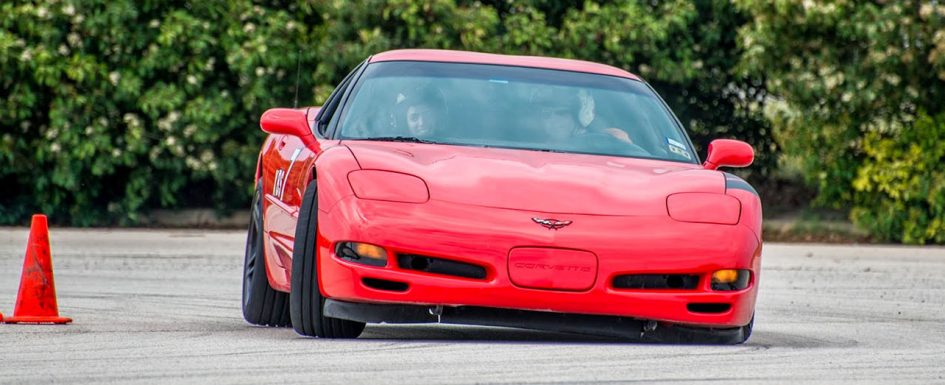This is the first part in a 2-part series…
Explained: Weight transfer vs body roll (part 2)
Body roll and weight transfer are amongst the most misunderstood aspects of vehicle dynamics. The physics of vehicle dynamics is indeed incredibly complex, but the problem is exacerbated by the sheer amount of really bad (and dead wrong) information that is often passed along from other well intentioned but misinformed drivers. In this post, we will attempt to clear up these oft confused concepts, and try do so in terms that are easy to follow.
Cause and effect
Many people, through no fault of their own, were taught that reducing body roll is essential because it will reduce weight transfer. While that statement sounds reasonable, unfortunately, it is flatly wrong. Reducing roll (1) has virtually zero effect on total weight transfer, and depending on the methods we use to control body roll, (2) we can only influence where the weight transfer goes. We will explore both of those statements more fully.
Consider this: A go-kart has no suspension and exhibits near zero roll (the only minor roll is from the flexing of the tires and the chassis itself). Yet, despite almost no roll, it still experiences huge amounts of weight transfer. The fact is that weight transfer is an unavoidable phenomenon that occurs whether or not a vehicle rolls. Roll is simply the effect of a suspension reacting to weight transfer.
Just as taking Claritin or Benadryl reduces your symptoms without curing your allergies, reducing roll reduces the symptoms but does not appreciably cure weight transfer.
Weight transfer is bad because of how tire load sensitivity works, and ideally, we want as little of it as we can get. For example, when weight is transferred from the inside tire to the outside while going around a corner, the outside tires are able to generate more grip, but the additional grip that they gain is less than the amount of grip the inside tires lose, and our total grip is reduced. This is why we want to reduce weight transfer as much as possible. While body roll is also undesirable (though, not for the reasons you may be thinking), the challenge is that most of the available tools we have at our disposal to reduce body roll end up increasing weight transfer or creating other problems.
Race car setup involves balancing various compromises, and as we will see, reducing body roll is NOT always the most important goal. Tolerating body roll is sometimes more desirable than compromising other part of our setup.
A brief note before we dive in: Weight transfer is a very complex subject that we are going to simplify greatly here. We will talk through some of the physics at a high level, but do our best to keep things easy to digest. If you want more technical information, there are several excellent articles, such as this one which delves into the math of weight transfer in tremendous detail.
Weight transfer
When we accelerate, brake, or turn, weight transfer occurs because the grip from the tires creates a force through which we affect the momentum and inertia of the car. In the case of a turn, the car wants to continue in a straight line, but the tires are able to generate enough force to pull the car around a curve, which creates weight transfer to the outside of the car. Easy peasy so far. Our next step is to understand the components that make up weight transfer, so that we understand the factors we have control over. There are 3 components we will evaluate:
1. Unsprung weight transfer
As the name suggests, this is the weight transfer from all of the unsprung components of the vehicle. A vehicle that has no suspension such as a go-kart only has unsprung weight, and thus has only this component of weight transfer. Unsprung weight transfer is measured by this simple equation:
What this tells us is that the amount of unsprung weight transfered can only be affected by the amount of cornering forces (i.e. how hard we are cornering), the weight of our car, how high the center of gravity is, and how wide the car is. That’s it!
For vehicles with a suspension, this simple explanation applies to only a small part of the total weight transfer. The unsprung components on most cars are just the wheels, tires, brakes, and (depending on the suspension design) maybe the springs and shocks. Calculating the weight transfer for the bulk of the car that is sprung is a little more complicated.
Nonetheless, as we have seen, we can reduce unsprung weight transfer by:
- Reducing weight
- Lowering the center of gravity
- Increasing the width
2. Sprung weight transfer
It was easier to visualize and understand unsprung weight transfer because we could assume that the entire unsprung weight (the entire go-kart, for example) acted as a solid unit, and that all the forces acted through the center of gravity. Because there is no roll, if there is enough weight transfer, the only consequence is that eventually the vehicle/kart will tip over. With computing sprung weight transfer we need to determine how much of the weight transfer is responsible for trying to tip the vehicle over, and how much is causing the suspension to move and make the body roll. This introduces the concept of the roll center.
The “roll center” can be a challenging concept to wrap our heads around. A simple example is if you imagine putting a marshmallow on a skewer and roasting it over a flame. As you rotate the marshmallow by turning the skewer, the roll center for the marshmallow is (obviously) the skewer. What makes this concept a little harder to visualize with a vehicle is that the roll center isn’t a physical “skewer”, but rather an imaginary line running through the car from the front to the rear. Furthermore, this imaginary line moves around as the suspension moves! If you want more information about roll centers, here is a relatively succinct explanation. If this all seems a bit abstract, don’t worry about it. Other than having a general idea of what it is, knowing the exact technicalities of the roll center is not important for most of us.
Sprung weight transfer is made up of 2 sub-components. The first is based on the height of the roll center from the ground (called geometric weight transfer) and works very similarly to unsprung weight transfer. Think of this as moving the skewer with the marshmallow on it from side to side, but not rotating it. The second is based on the height of the center of gravity from the roll center (called elastic weight transfer), and is the component of weight transfer that is taken up by the springs and bars. Think of this as rotating the skewer to make the marshmallow roll.
KEY LEARNING: Elastic weight transfer is the only force that is responsible for body roll.
The equations for these 2 sub-components are:
Elastic weight transfer = lateral force * weight * (center of gravity height – roll center height) / width
Don’t be intimidated by these formulae! You don’t actually need to do any math. All we need to know is that total sprung weight transfer is the sum of both of them, and that the location of the roll center determines which component we get more of. There are a few cases to consider:
- If the roll center is exactly as high as the center of gravity, the car will have only geometric weight transfer and no elastic weight transfer at all (because the height of the center of gravity minus the height of the roll center will be zero). This will make the car have no roll at all, but the jacking/tipping force will be high.
- If the roll center is below center of gravity but above the ground, the car will have some geometric weight transfer and some elastic weight transfer. Thus, the car will have some (hopefully manageable) amount of weight jacking and roll. This is the most common scenario.
- If the roll center is at ground level, the car will have no geometric weight transfer, and lots of elastic weight transfer. This will exhibit itself as a car with no tipping force, but tremendous amounts of body roll. The only way to counteract this would be to use really stiff springs and/or sway bars, but both of those solutions bring other problems with them.
In other words, by moving the roll center we can significantly change the rolling behavior of the car, but we cannot affect the total amount of weight transfer. For most of us, this isn’t a particularly useful tuning tool because unless we are racing a car where we have the ability to significantly alter the suspension geometry, we don’t have much control over changing the roll center location.
As for reducing sprung weight transfer, once again, our only options are:
- Reducing weight
- Lowering the center of gravity
- Increasing the width
3. CG displacement weight transfer
There is a very small component of weight transfer which comes from the slight sideways shift of the center of gravity of the car as it rolls, but it has such a minor effect compared to the rest of the weight transfer, that it is effectively negligible. This is the reason we said above that reducing roll has “virtually zero” effect (instead of NO effect) on weight transfer. Reducing roll only reduces this really minor component of weight transfer. The math for proving this gets pretty complex, but if you are curious, you can check it out here (search the page for “Elastic Load Transfer Component”). The gist is that the weight transfer caused by CG displacement from body roll can be safely ignored.
Phew. That wasn’t so bad, right? What we have established so far is that:
- Weight transfer is bad, and we would like to reduce total weight transfer
- Total weight transfer can only be affected by weight, height of center of gravity, and width
- Reducing roll will not appreciably reduce weight transfer
But body roll is undesirable in its own ways, and we probably want to reduce it as much as possible too, as it creates 3 significant problems that apply to all cars, and a 4th that only applies to cars with significant aero (do you know what these problems are?).
Next time, we’ll dig into these issues, and talk through the compromises that arise from the various methods we have at our disposal to reduce roll.


thank you so much sir you probably dont understand how helpful this has been to me